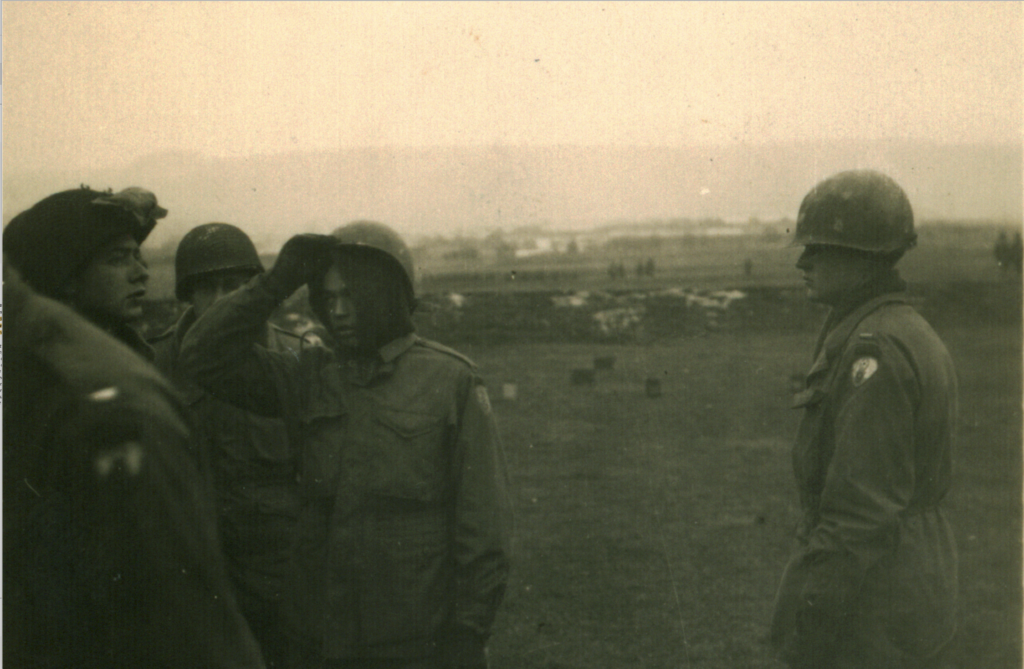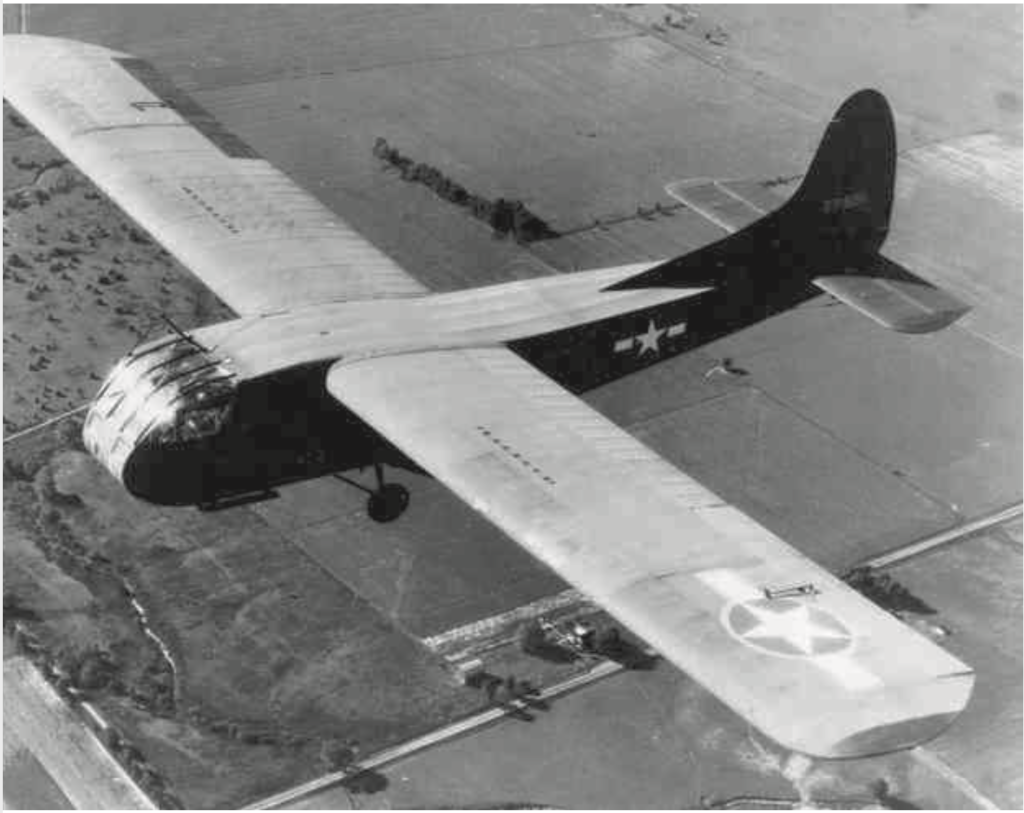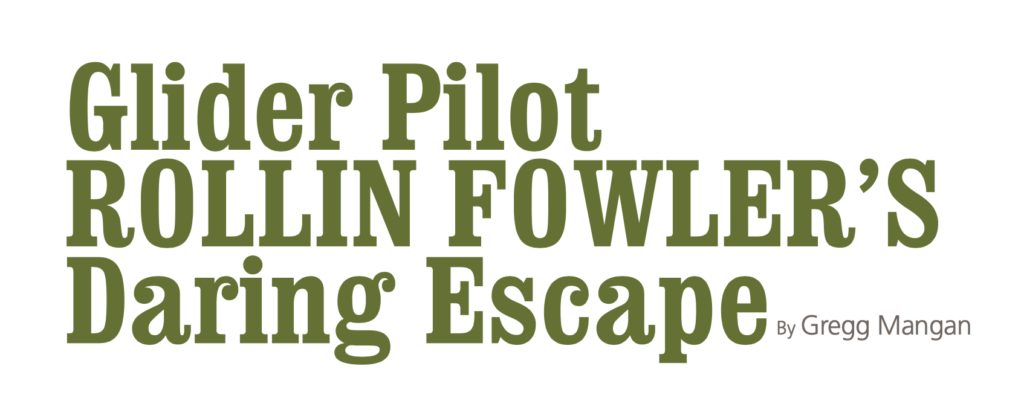
(far right) Rollin Booth Fowler, Ogbourne St. George, England, December 1944 or January 1945.
City of Lubbock, Silver Wings Museum
(c) Connecticut Explored Inc. Fall 2020
Subscribe/Buy the Issue!
Rollin Booth Fowler was a native of Bethany, Connecticut who served his country in remarkable fashion during times of war. He flew in support of some of the most famous operations in American military history, and, in carrying out his duty, contributed his own extraordinary story to the abundant narratives of bravery and heroism that came out of the Second World War.
Fowler graduated from high school in 1940 and went to work for the Duo-Therm Air Distribution Company in West Haven. The following year the Japanese attacked Pearl Harbor, officially drawing the United States into World War II. Fowler, having just turned 18, enlisted in the army. He spent a year training with a field artillery unit before transferring to the air corps, where he volunteered for glider service. Gliders are engineless aircraft designed to carry troops and equipment on essentially one-way missions.
Glider training took Fowler all over the United States before ultimately landing him in Newbury, England in early 1944. With the Germans busy fighting the Russians in eastern Europe, the Allies sought to secure a military foothold in western Europe by launching an invasion of Nazi-occupied France. A successful operation would, among other things, force the Nazis to fight the war on two fronts. Heading up the invasion was American General Dwight Eisenhower. Fowler served as a personal bodyguard for Eisenhower and for English Prime Minister Winston Churchill during their pre-invasion troop inspections that spring.
On June 6, with his wife Jeanne at home nursing their newborn son, Fowler took part in the Allied invasion of Normandy, France. According to histories gathered by the New York State Military Museum, Fowler was a part of a mission called “Elmira”—the final assault of the 82nd Airborne on what came to be known as “D-Day.” Fowler and his fellow glider pilots undertook the task of resupplying the paratroopers who had landed behind enemy lines earlier that morning.
Attached to the back of a C-47 transport plane, Fowler took to the skies around dusk. He piloted his glider across the English Channel before detaching and sailing toward St. Mere Eglise along the French coast, carrying with him an estimated 7,000 pounds of materials and a number of soldiers. Fowler’s plane soon found itself subjected to heavy enemy ground fire and crash-landed roughly five miles behind enemy lines. Unknown to Fowler at the time, his landing zone had not yet been secured by the paratroopers who landed earlier that day.
When Fowler and the surviving men emerged from the broken glider, they encountered German soldiers intent on storming their position. Fowler later said that he managed to kill five with a hand grenade and four more with a rifle before the explosion of a German grenade knocked him unconscious. When he awoke, he was a prisoner, along with the two other Americans still alive.
The Germans transported Fowler to one of their nearby regimental headquarters. As the enemy commenced their interrogation of him, however, droning propellers announced the arrival of U.S. Thunderbolt and Lightning fighter planes. The planes began strafing the area while American ground troops augmented the attack with artillery fire. Stores of ammunition caught fire and exploded, sending German soldiers scrambling.
Fowler took advantage of the chaos to sneak out of the headquarters building and duck behind a stone wall. A few moments later, the Hartford Courant reported March 17, 1945, a German colonel drove up in a staff car. To Fowler’s great fortune, he still had a hand grenade overlooked during a previous search. Throwing the grenade in the direction of the staff car, Fowler killed the colonel and another soldier. He then quickly grabbed the colonel’s binoculars and a carbine and ran down the road, where he procured a German motorcycle and used it to race back to the Allied lines.
Fowler eventually arrived safely back in England, but his service to America’s war effort proved far from over. Just three months after D-Day, the Allies launched Operation Market Garden in an attempt to make a quick and decisive move into northern Germany. The plan called for Allied airborne divisions to drop into the Netherlands and secure key bridges along an approximately 80-mile corridor. Once again Fowler took to the air in his glider to help land troops and supplies along the proposed route. Fowler successfully landed his men and supplies but Operation Market Garden ultimately failed when the last bridge was overrun by German reinforcements and the Allies were forced to abandon the assault.

The type of glider Rollin Fowler piloted, a U.S. Army Air Force Waco CG-4A-WO glider, 1943. Deep River’s Pratt-Read manufactured 956 of these gliders during World War II.
National Museum of the U.S. Air Force
After participating in the four major airborne invasions of the war, Fowler returned to Connecticut at the end of the war. He had been promoted to second lieutenant. His unit, the 435th Troop Carrier Group, won the Presidential Unit Citation for its performance in Normandy.
Fowler went on to serve in the Korean War before returning once again to Connecticut and moving to Unionville. He passed away at John Dempsey Hospital in Farmington in 1987 at age 64 and received a burial with full military honors at Arlington National Cemetery.
Gregg Mangan is the manager of digital humanities at Connecticut Humanities (CTH). This article is adapted from one he wrote for CTH’s ConnecticutHistory.org.
Explore!
Receive each beautiful and informative issue — Subscribe Today!
Read more stories about Connecticut in World War II in our Fall 2020 issue, and on our Connecticut at War TOPICS page.
Read more stories about Notable Connecticans on our TOPICS page.

